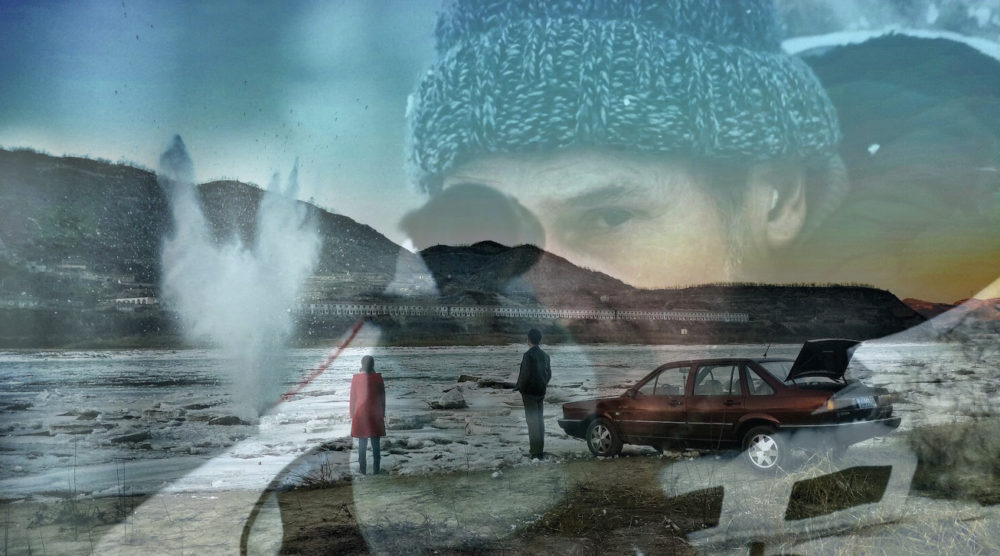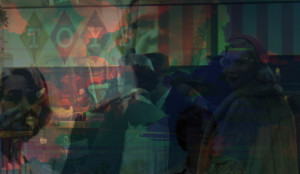
[Editor’s note: Derek’s capsules were initially published on his Letterboxd account.]
Disco Inferno (Alice Waddington, 2015)
Everything about Alice Waddington’s Disco Inferno signals that she should be making feature films immediately. It is, after all, very reminiscent of the kind of nostalgic but original work that Guy Maddin creates. It’s a short that falls somewhere between classic and modern because of its influences – Italian cinema, silent cinema, and Georges Franju, who the film is dedicated to – and because of the fact that its B&W photography is as crisp and flawless as it gets.
This isn’t style over substance though, with imagery that feels pulled out of a Ken Russell film and shoved into a sixties cult classic, complete with an actual cult and satanic rams to to get the blood pumping. It feels more like a mood piece than anything with a traditional narrative, though not quite as experimental as the aforementioned Maddin. Instead, it simply presents us with a woman (Ann Rujas, who looks like Julie Newmar dressed as Catwoman) seemingly trespassing in a strange home to rescue a young woman, who instead ends up in a confrontation with another woman who identifies as “the supreme one” and “mother of the triangle”.
Waddington goes for ambiguity in their relationship, never quite stating whether they’re former lovers, colleagues, enemies, or it’s all just part of a strange performance piece, which works to enhance the film’s strangeness, though an ending that feels tacked on and a little too off-beat muddles that a bit. But in under twelve minutes, Alice Waddington creates a strange little world out of complementary aesthetics that deserves expansion: are these women actually the Devil and Mephistopheles? If so, why is their relationship so strained? Who was that girl running away from the cult? Why are there heads on walls? Why is there a weird office party? Disco Inferno is the kind of short that makes you beg for a feature and I want it right now. [JB]
Flesh + Blood (Paul Verhoeven, 1985)
Well, the title’s accurate.
In the same blood- and mud-caked reason vs. superstition ballpark as In the Name of the Rose. But this being a Paul Verhoeven film, it’s about a million times sleazier, starring a menagerie of degenerates doing degenerate things led by the incomparable Rutger Hauer, following the chevauchée trifecta to a tee. This is even before they decide to exact bloody revenge on an Italian nobleman for welching on a payment.
This is a beautiful movie about nasty things, where one of the key images is a pair of betrothed lovers munching on mandrake beneath the decaying bodies of hanged men. By the end of the movie, the boy will be chained like a dog and the girl will be violated by the Christ figure of the story. It can’t quite pull off the tonal juggling it attempts, and it’s about 20 minutes too long, but it’s a fascinating piece of work that sets the tone for the next decade and change of Verhoeven’s career. As is, this is like a 16th-century pamphlet on the Evils of Mortal Sin adapted into an HBO-ready sleazefest, so naturally, YMMV. [DG]
Sunset Song (Terence Davies, 2015)
Need something to fill the void that Outlander season two ending left in your heart for period dramas led by women with agency, featuring hot Scottish men, whippings, weddings, and wee bairns? Look no further than Terence Davies’ Sunset Song, adapted from Lewis Grassic Gibbon’s novel of the same name.
Wheat has never looked so damn good on screen as it does in Sunset Song, but for all the beauty of the natural that he showcases, Davies never shies away from the often bleak realities of being a woman in the 1900s. This tale of the daughter of a Scottish farmer could have easily slipped into the land of misery porn or the overly romantic territory of Thomas Vinterberg’s Far From the Madding Crowd, but Davies never lets himself get swept away by tragedy or love.
Moments of joy and grief are presented with the same fixed lens as Davies forces the audience to be as impartial a viewer as he is a filmmaker. It’s all in the beautiful images, words and landscapes brought to life with love and care by Davies and his talented actors. Agyness Deyn’s breakout performance as the protagonist Chris in all her stony glory and her co-star Kevin Guthrie’s heart-wrenching performance in the latter act make every scene a pleasure to watch.
Chris’ narration occasionally guides the narrative, but it’s a feature rendered mostly unnecessary as the visuals and scene to scene dialogue tell all. If anything, a few lines makes the rest worth having, such as this self-described queer thought: “Nothing endured but the land. Sea, sky and the folk who lived there were but a breath. But the land endured. And, at that moment, she felt in the gloaming that she was the land.” Sunset Song is ultimately a tale of endurance for its protagonist and it may very well be one for audience members who can’t quite settle into period dramas too. Those who can settle into its wavelength however will find themselves lost in the bittersweet beauty that Davies’ latest has to offer. [JB]
The Grey (Joe Carnahan, 2011)
“Talkin’ tough leads to jack shit now. You’re not scared? You’re a fool. Worse, you’re a fuckin’ liar.”
Plays like the Northern Hemisphere’s answer to Wake in Fright, a white-knuckle survival thriller where toxic masculinity rules the day. Except The Grey does it one better by removing the framework of civilization, thus nakedly exposing the roughneck swagger as mere, as Liam Neeson puts it, “chest-puff bullshit.”
And there’s a certain Fulci-esque doomsday quality to the film; the second those people get on the plane, there’s a pervasive point-of-no-return feeling. These men are leaving Hell for a far worse place. They’re the sacrificial lambs on the altar of Nature, sent to die to atone for the hubris of Man in the wilderness. Lots of fist-shaking at God interspersed with the Bear Grylls hard-mode survivalist stuff, as if this was made by a dude who thinks that Winter Light, Cliffhanger, and The Edge are the three best movies ever made. Which I wouldn’t put past a guy like Carnahan, who loves his junk, sure, but also happens to be a very skilled director.
Fucked up how this movie made me cry. Twice. The first time involved Neeson talking a man through his death. The second involved Neeson stacking the wallets of the dead at a makeshift campsite, half inuksuk, half gravestone. [DG]
Under the Shadow (Babak Anvari, 2016)
“The Iran-Iraq war is thought to be the longest conventional war of the twentieth century, lasting from 1980 to 1988. Throughout the conflict Iran underwent rapid internal, political, and cultural transition: a legacy of the bloody 1979 Iranian Revolution. Towards the end of the decade, Iraq launched a series of strategic bombings on Iranian cities. Iran retaliated in the same way. Lives were plunged into darkness where fear and anxiety thrived.”
The opening text of Babak Anvari’s debut offers a miniature history lesson alongside a warning for the film to come: fear and anxiety thrive in darkness. It spells out its message plainly and, from there, works on slowly unnerving the audience and its protagonist Shideh (played compellingly by Narges Rashidi), a mother who can’t go back to her studies after being “politically active” in her youth and whose husband is away during this troubled time. Even with the presence of a djinn clear to most of the individuals surrounding her, Shideh is more frustrated with the limitations society is placing on her. After an unsettling incident, one man tells her, “A woman should be scared of exposing herself more than anything else, so be ashamed.”
And while the scares aren’t particularly high in Under the Shadow, it’s a film that shows effort in maintaining the ambiance of a certain war-torn period. It’s not just that the costuming and production design never feel heavy-handed (though Jane Fonda’s workout tape being present is a delightful breath of fresh air), it’s that the entire film seems tailored to reflect the horrors of life during wartime. One especially gorgeous image is of Shideh giving up on a man who she’s been performing CPR on, letting him die as a missile that hasn’t detonated sits comfortably lodged in the roof behind them.
It’s an uncanny sign of impending doom and mostly limiting the film to an apartment building with a bomb shelter allows for tension to be amped up easily. Comparison to The Babadook are inevitable though the film’s share entirely different visual styles and narratives, and while The Babadook focuses on its protagonists mental state as well as making a real threat out of its titular monster, Under the Shadow instead focuses on showing how situational fear can tear a family apart and bring them together. [JB]
Mauvais sang (Leos Carax, 1986)
Plays like a video artist’s version of a film noir. All the tropes are there, like the femme fatale and the One Final Job, but they’re all presented in a canted way. The femme fatale is technically Juliette Binoche, “luring” Denis Lavant into a job he didn’t want to take, but this is no fault of hers (her character, Anna, is charming and sweet to a fault). Lavant, here 24 and already in possession of one of the great character actor faces of all time, is a snot-nosed nihilist punk whose defining character traits are his dexterity, his grand pronouncements on human behaviour, and his propensity for shadowboxing. Even Julie Delpy’s Lise is a riff on the innocent caught in the crossfire: by the end, she’s hauling ass on a motorcycle, white kicks covered in blood, mouth covered with a scarf as if she were guilty of something. They, like the older cons and the boss on their tail, are deliberate subversions of old crime movies. Even the dialogue has a Vian-esque whiff of po-mo hardboiled prose.
But ultimately it’s more concerned with personal ennui that the job at hand. Every act feels like it’s being done in order to fend off tedium: dancing, having sex, planning a heist. It helps that the movie’s load-bearing beams are not scenes per se, but hyper-stylized tangents: the scuffle between Lavant and Michel Piccoli, where their faces and hands get smooshed onto a pane of glass. Or the montage where Lavant goes full slapstick trying to make Binoche laugh. Or any number of elliptical insert shots Carax splices into the film, each more electrifying that the last. There are also dollops of bargain-bin sci-fi (the heist, the STD throughline) that just sweeten the pot for me.
Also, how the fuck was this not called Bad Blood in English?! [DG]
Mountains May Depart (Jia Zhange-ke, 2015)
Full disclosure: I’ve never seen one of Jia Zhang-ke’s films prior to Mountains May Depart. In it, I found something beautiful though; an ambitious work of art that remains shockingly intimate through and through. Jia’s film is, simply put, a glimpse into the life of Shen Tao and the men that surround her. The first act takes place in 1999, where Tao must choose between the two men in her life and deal with the repercussions of that on their friendship. The second act moves us to 2014 where Tao is divorced and has a strained relationship with her son. The third, undoubtedly the portion of the film that will isolate many viewers, moves from China to Australia, pushes us to the future in 2025, and shifts dialogue between English and Mandarin.
With the first two acts focused on Tao, the third is focused on the idea of her, choosing to highlight her son’s life and the relationship he establishes with a teacher who subconsciously reminds him of the mother he no longer knows. What seems like a real shift in character focus is actually a fascinating continuation of how people consistently choose progress over tradition and how we all eventually long for the histories and comforts of the past. These aren’t heavy-handed lessons that Jia is dishing out, working hand in hand with the multi-decade narrative he’s weaved primarily surrounding one woman.
In distinguishing each act and decade, Jia also shifts aspect ratio: 1.37:1 for 1999, 1.85:1 for 2014, and 2.35:1 for 2025. Where Wes Anderson went for a flashier approach to this, Jia simply uses it to establish period, but the images caught on screen are gorgeous. Moments where the audience views the characters from afar on a breathtaking landscape are as impacting as those where individuals are trapped in close-up, delivering succinct and emotional dialogue. The sole constant, outside of the characters, is Yoshihiro Hanno’s score, bridging together the universes of the past, present and future, all of which feel lived-in and realistic even though we’re only getting a minor glimpse into them. [JB]



 Derek
Derek
 Isabelle
Isabelle